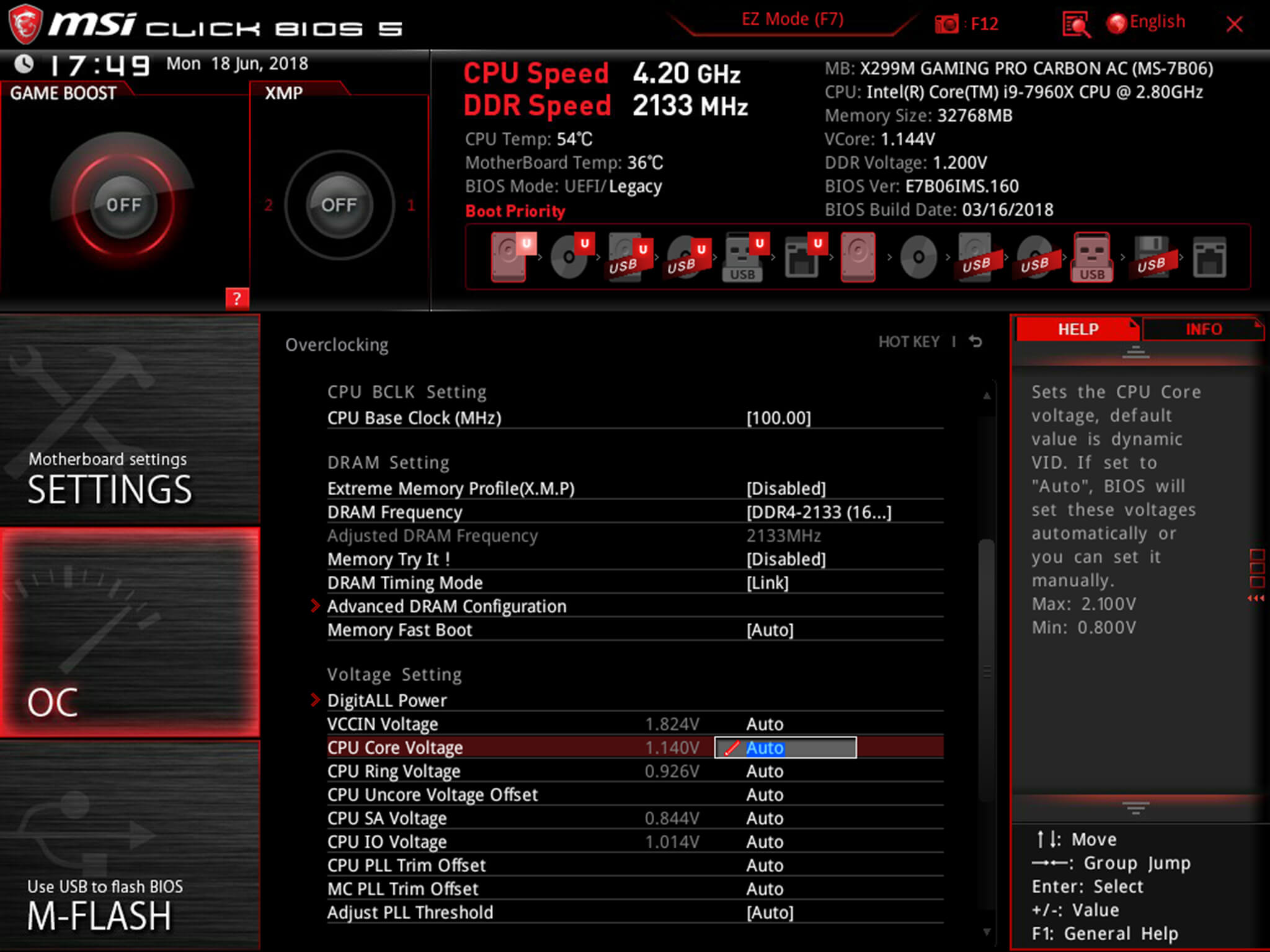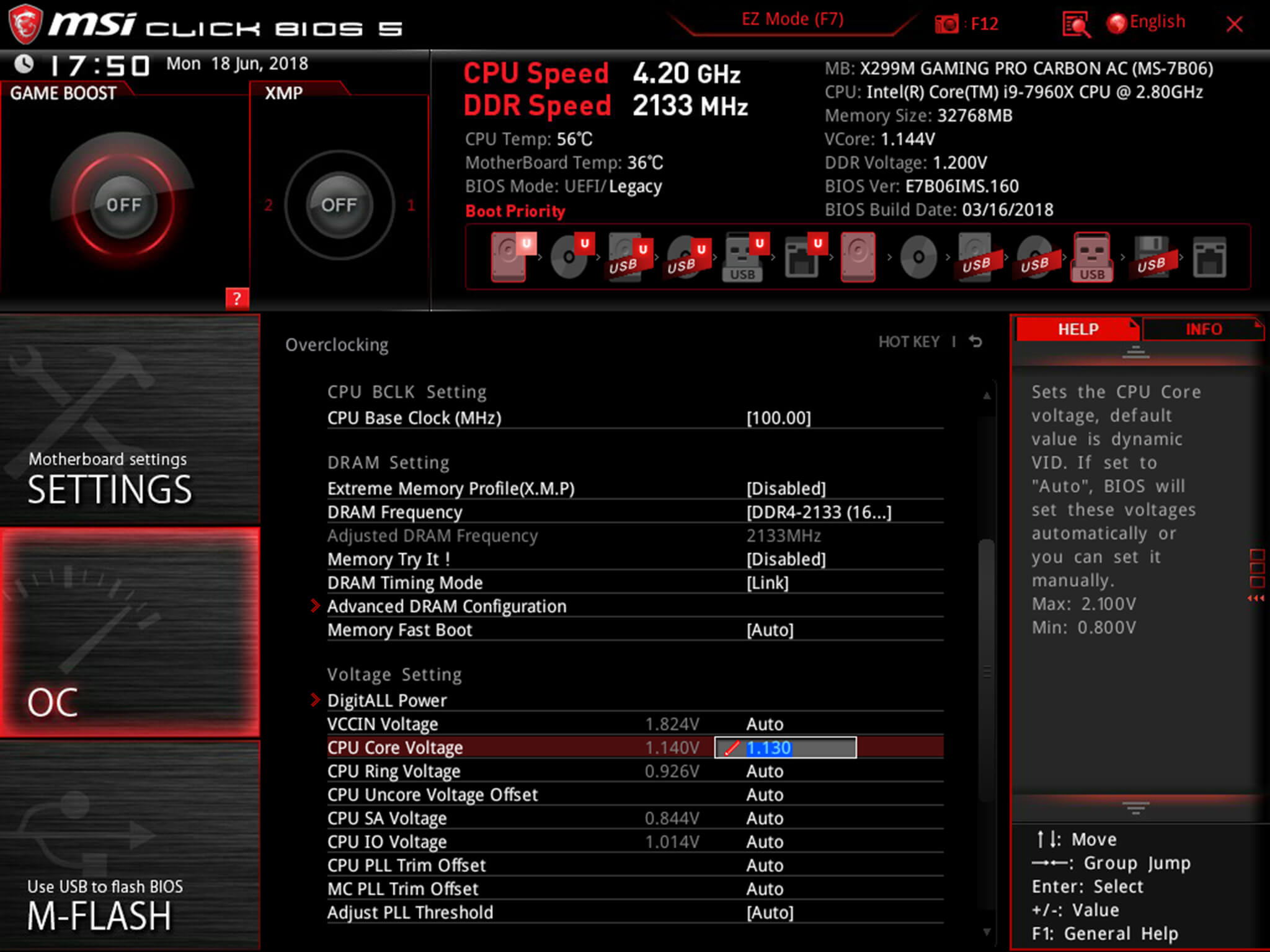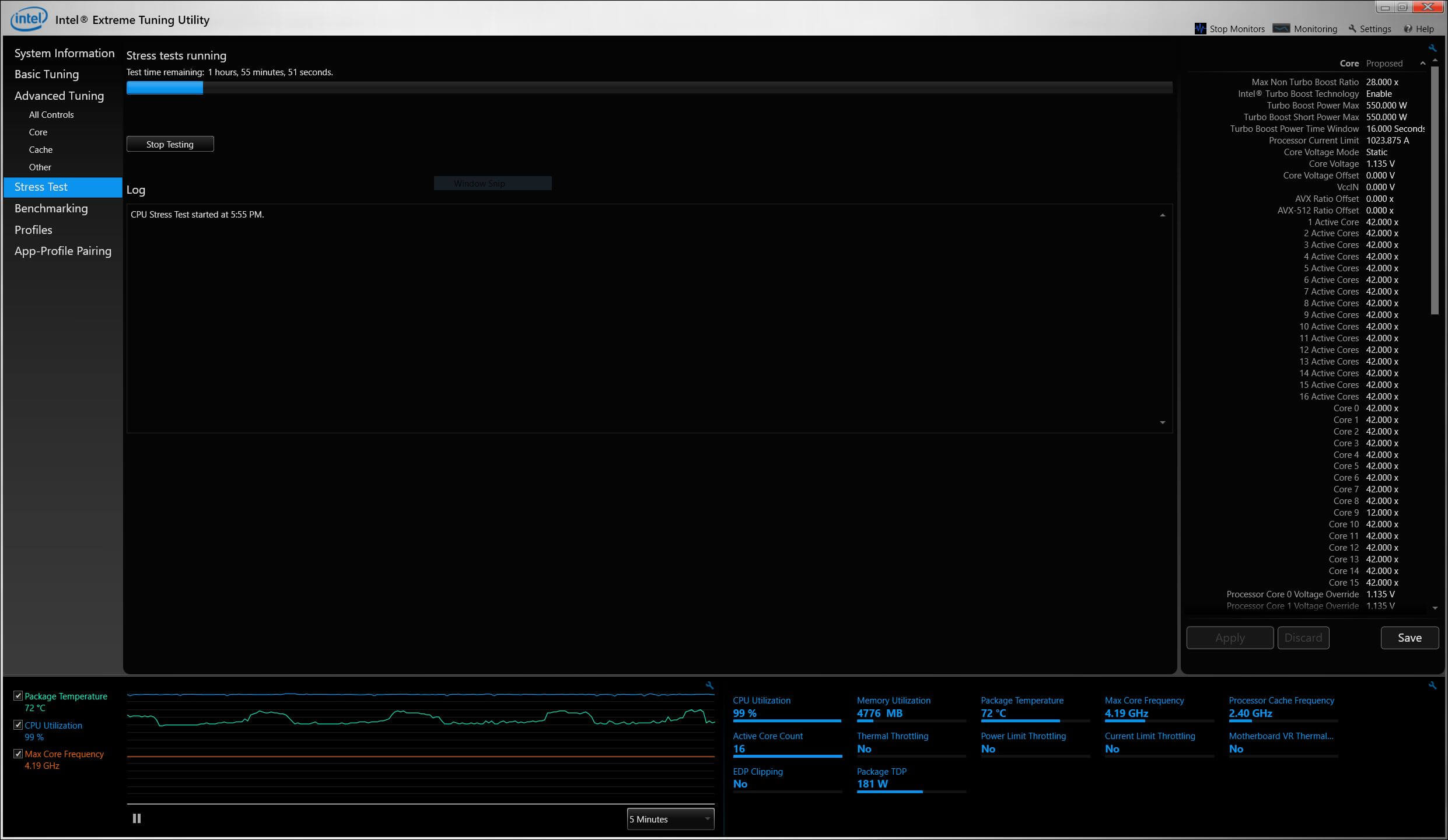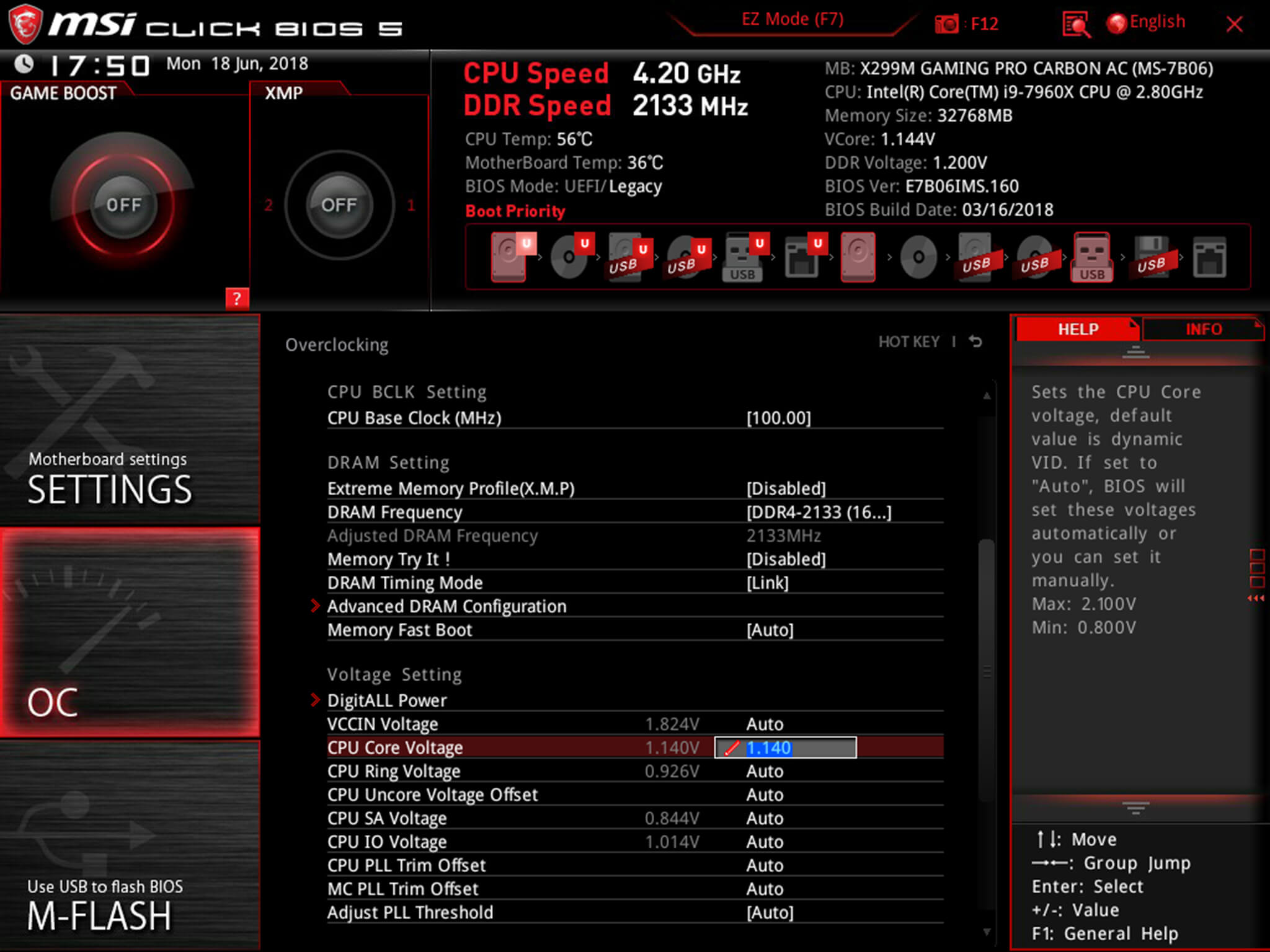The core voltage is different for each processor model, and while all CPUs of the same model have the same VID, not all samples maintain stability at the same clock speeds and Vcore due to slight variations in silicon quality. Every sample of the same CPU model is tested to maintain stability at the default speeds and the VID determined by the manufacturer.
Core voltage typically maintains a constant value while your CPU is in use; however, sometimes under heavy workloads vcore can fluctuate. This is known as Vdroop and can be corrected with load-line calibration. This applies additional voltage as load increases to maintain your CPU's stability.
When it comes to overclocking, you can only push your CPU's frequency so far before your CPU starts to experience instability. Programs might begin to crash or hang up, game performance could suffer or your computer could even fail to boot. This is because your processor isn't getting enough voltage to maintain system stability.
Increasing voltage will allow you to dial in the perfect overclock.
To adjust the voltage, you'll need to boot into your motherboard's BIOS and make adjustments there. The Vcore is expressed as a three decimal value, such as 1.235v. By default, the voltage control is set to auto; this can be overridden by typing in any value. Make sure not to exceed the recommended maximum for your processor.

Before fine-tuning the Vcore, it's important to find a good baseline value for a given speed. This varies from model to model but it can be helpful to read reviews for your CPU, specifically ones that focus on overclocking.
Most publications will list the voltage they required to keep several different speeds stable. Every CPU sample is different and you will need to fine-tune the voltage before calling it done; however, these values do provide a good starting point.

If you boot your machine and don't find any stability issues, then you know it's time to start decreasing the voltage. When overclocking, you want to find the lowest voltage required to maintain stability. More voltage equals more heat and this will allow you to keep temperatures under control.

The safest way to adjust voltage is with increments of .01 volts. Decrease voltage until your computer starts showing signs of instability under load. Use a program like Intel's Extreme Tuning Utility (XTU) or Prime95 to stress test your processor.
If the test fails or crashes, then you need to raise the voltage back up to the previous stable point. For optimal efficiency, you can increase the voltage by .005 instead and again test for stability.

Conversely, if your overclock isn't stable at your baseline voltage, you will then need to increase the voltage until your computer shows no adverse effects and then decrease in increments of .005 to fine tune.

Overclocking is not the only time it can be useful to adjust voltage. As mentioned, higher voltage levels cause your CPU to generate more heat, regardless of frequency. Some CPU samples may have a higher VID than is actually required at the default frequency. Undervolting your processor allows your to maintain stability while decreasing temperatures and extending the life of your processor.
It's a common misconception that disabling Turbo Boost is a more effective substitute for shedding heat. While this does result in decreased temperatures, it is not an alternative as the purpose of undervolting is to maintain the same level of performance while generating less heat. When making adjustments, the same principles apply here as with overclocking, decrease Vcore in increments of .01 and then fine tune with adjustments of .005.
 Best travel deal: Score the Frontier Go Wild! summer pass for just $399
Best travel deal: Score the Frontier Go Wild! summer pass for just $399
 Miami Heat vs. Los Angeles Lakers 2025 livestream: Watch NBA online
Miami Heat vs. Los Angeles Lakers 2025 livestream: Watch NBA online
 Asus Zenbook deal: Save $350 at Best Buy on this 8GB OLED 14
Asus Zenbook deal: Save $350 at Best Buy on this 8GB OLED 14
 Watch SpaceX set free Blue Ghost and ispace moon lander in space
Watch SpaceX set free Blue Ghost and ispace moon lander in space
 Apple is reportedly still working on smart glasses of some kind
Apple is reportedly still working on smart glasses of some kind
 Watch SpaceX set free Blue Ghost and ispace moon lander in space
Watch SpaceX set free Blue Ghost and ispace moon lander in space
 Best Gaming Router Deal: Save $329 on NETGEAR Nighthawk AXE11000
Best Gaming Router Deal: Save $329 on NETGEAR Nighthawk AXE11000
 YouTuber GamersNexus sues Honey over alleged scam
YouTuber GamersNexus sues Honey over alleged scam
 Your 'wrong person' texts may be linked to Myanmar warlord
Your 'wrong person' texts may be linked to Myanmar warlord
 Best Amazon deal: Save 30% on the EcoFlow Delta 3 Plus portable power station
Best Amazon deal: Save 30% on the EcoFlow Delta 3 Plus portable power station
 The Baffler’s May Day Round Up
The Baffler’s May Day Round Up
 I went to the 'Severance' pop
I went to the 'Severance' pop
 How to live stream the New York Knicks in 2025
How to live stream the New York Knicks in 2025
 Wordle today: The answer and hints for January 15, 2025
Wordle today: The answer and hints for January 15, 2025
 Amazon Big Spring Sale 2025: Best air purifier deals from Dyson, Shark, LG, and more
Amazon Big Spring Sale 2025: Best air purifier deals from Dyson, Shark, LG, and more
 Best TV deal: Save $200 on Amazon Fire TV 55
Best TV deal: Save $200 on Amazon Fire TV 55
 Best robot vacuums from CES 2025: Most are cool, only some are practical
Best robot vacuums from CES 2025: Most are cool, only some are practical
 Miami Heat vs. Los Angeles Lakers 2025 livestream: Watch NBA online
Miami Heat vs. Los Angeles Lakers 2025 livestream: Watch NBA online
 Amazon Spring Sale 2025: Best Apple AirPods 4 with ANC deal
Amazon Spring Sale 2025: Best Apple AirPods 4 with ANC deal
 Best Fire Max 11 bundle deal: Save $74.98 at Amazon
Best Fire Max 11 bundle deal: Save $74.98 at Amazon
Nana Nkweti, Fiction by Nana Nkweti'True Detective: Night Country' and the Dyatlov Pass incident, explainedMrBeast earns more than $250,000 on video uploaded to Elon Musk's XNana Nkweti, Fiction by Nana NkwetiChestnut Trees by Hermann Hesse26 billion records have been leaked in 'Mother of all Breaches,' but don't freak outWhy TikTok's For You page isn't a safe space for womenOn Watery Artworks and WritingAnaïs Duplan, Nonfiction by Anaïs DuplanShark Tank keto gummies are a scam. Yet, Google keeps letting scammers run search ads.Chestnut Trees by Hermann HesseRedux: The Poet’s Nerve by The Paris ReviewJamaica Kincaid’s Rope of Live Wires by Maya BinyamRedux: The Marketing of Obsession by The Paris ReviewCooking with Sergei Dovlatov by Valerie StiversIntroducing the Winners of the 2022 Whiting Awards by The Paris ReviewOn Liberated Women Looking for Love by The Paris ReviewAnaïs Duplan, Nonfiction by Anaïs DuplanDiary, 1999 by Sloane CrosleyWordle today: The answer and hints for January 23 YouTube testing free picture Google Assistant can talk like Yoda and buy your 'Star Wars' tickets Mozilla's Pocket begins sticking sponsored content in new Firefox tabs Elon Musk fires back, defends behavior on recent Tesla earnings call Hawaii volcano eruption brings the state's worst earthquake in decades Turns out this high school's mystery pooper is a different district's superintendent Sandra Bullock on 'Ocean's 8' all Greenhouse gas concentrations hit highest level in human history Development of Vine successor, V2, postponed indefinitely Here's how to survive your graduation ceremony Uncovered police document from the 'Satanic Panic' of the 1980s is incredibly bizarre Lego and Amazon Alexa launch roleplaying Echo game for young builders Dear White People’ Season 2 unleashes your primal scream at America The mute button is Twitter's most underrated feature 'Tully' writer Diablo Cody talks women in film, on screen and off Donald Glover packed 'This Is America' with a lot of hidden meaning Facebook's 'M' assistant might actually have a name A bunch of the original 'Avengers' got matching tattoos because of course they did The 10 best 3D printers for beginners Ham ice cream is the newest thing that no one asked for
1.8444s , 10133.4765625 kb
Copyright © 2025 Powered by 【Busty Cops on Patrol (2009)】,Unobstructed Information Network